NASA developed a method to screen low outgassing material to be used in space. The test determines the volatile content of material samples placed in a heated vacuum chamber. ASTM E595 is the standard test method for measuring outgassing in adhesives and other polymer materials. Results are highly dependent on how the adhesive is cured. Results of the test vary based on cure. Once the sample is cured according to manufacturer suggested cure schedule(s), the samples are preconditioned at 50% relative humidity for 24 hours then weighed. The sample is then placed in a vacuum chamber at 125°C at 5×10-5 torr. For the 24 hours the sample is in the test chamber, any volatiles that outgas are condensed and collected on a 25°C collector plate. The sample and condensate on the collector plate are then weighed to determine the total mass lost (TML) by the sample and the amount of collected volatile condensable materials (CVCM) on the collector plate. The material passes or fails based on total mass loss (TML) and collected volatile condensable materials (CVCM). To meet NASA Outgassing requirements, TML must be less than 1% and the CVCM must be less than 0.1%. Both requirements must be met to be considered a NASA Low Outgassing material.
Most recently, EB-135 was tested for NASA Outgassing and passed at 3 different cure schedules. EB-135 is an epoxy adhesive and potting compound that can cure at room temperature and exhibits exceptional chemical resistance. It is an unfilled epoxy with excellent optical properties. Below are NASA Outgassing results for all 3 cure schedules. Please click here to learn more about EB-135.
Cure: 24 hours at 25°C
TML – 0.83% CVCM – 0.08%
Cure: 3 hours at 65°C
TML – 0.59% CVCM – 0.06%
Cure: 2 hours at 80°C
TML – 0.60% CVCM – 0.07%


